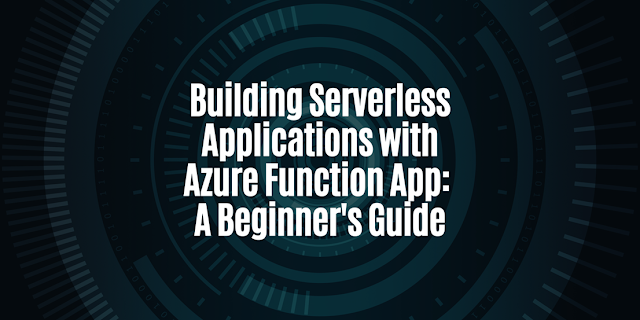Serverless computing is a new way of building and deploying applications that eliminates the need for provisioning and managing servers. Instead, it allows developers to run their code in response to events and automatically scales to meet the demands of their application. Azure Function App is Microsoft's serverless computing platform that enables developers to build event-driven, scalable, and cost-effective applications. In this article, we will provide a beginner's guide to building serverless applications with Azure Function App.
Serverless computing is built on top of cloud infrastructure and enables developers to focus on writing code rather than managing servers. Azure Function App is a serverless compute service that allows developers to run event-triggered code without the need to provision or manage infrastructure. It supports a wide range of languages, including C#, F#, JavaScript, TypeScript, Java, and Python, and can be integrated with other Azure services, such as Azure Event Grid, Azure Event Hub, and Azure Cosmos DB.
One of the key benefits of serverless computing is its ability to automatically scale to meet the demands of your application. Azure Function App automatically scales out and in based on the number of incoming requests, and you only pay for the compute resources that you use. This can result in significant cost savings, especially for applications with infrequent or unpredictable workloads.
In this article, we will walk you through the process of building a simple serverless application using Azure Function App. We will cover the following topics:
- Setting up an Azure Function App
- Creating a new function
- Configuring triggers and bindings
- Testing and debugging functions
- Deploying functions to Azure
Before we begin, you will need to have an Azure account, and you can sign up for a free trial if you don't have one.
Step 1: Setting up an Azure Function App
To create a new Azure Function App, you can use the Azure Portal, Azure CLI, or Visual Studio. In this example, we will use the Azure Portal.
- Log in to the Azure Portal (https://portal.azure.com/)
- Click on the "Create a resource" button
- Search for "Function App" and select it from the list
- Fill in the required fields, such as the name of your function app, the subscription, and the resource group
- Select the runtime stack for your function app (e.g. .NET, Node.js, Java, etc.)
- Select the hosting plan for your function app (e.g. Consumption Plan, Premium Plan, etc.)
- Click on the "Review + create" button to review your settings
- Click on the "Create" button to create your function app
Step 2: Creating a New Function
Once your function app is created, you can create new functions within it. In this example, we will create a simple function that returns "Hello, World!" when called.
- Log in to the Azure Portal (https://portal.azure.com/)
- Navigate to your function app
- Click on the "New function" button
- Select "HTTP trigger" from the list of templates
- Enter a name for your function (e.g. "HelloWorld")
- Select the authorization level for your function (e.g. "Function", "Admin", etc.)
- Click on the "Create" button to create your function
Step 3: Configuring Triggers and Bindings
A trigger is the event that causes your function to run, and a binding is the connection between your function and other Azure services. In this example, we will configure an HTTP trigger for our function.
- Log in to the Azure Portal (https://portal.azure.com/)
- Navigate to your function
- Click on the "Integrate" tab
- Under "Triggers", you will see the "HTTP trigger" that we created earlier
- Click on the "Save" button to save your changes
Step 4: Testing and Debugging Functions
Before deploying your function to Azure, you can test and debug it locally. In this example, we will use the Azure Functions Core Tools to test our function.
- Install the Azure Functions Core Tools (https://docs.microsoft.com/en-us/azure/azure-functions/functions-run-local)
- Open a command prompt and navigate to the folder where your function is located
- Run the following command to start the local host: "func host start"
- Open a web browser and navigate to "http://localhost:7071/api/HelloWorld"
- You should see the message "Hello, World!" displayed in the browser
Step 5: Deploying Functions to Azure
Once you have tested and debugged your function locally, you can deploy it to Azure. In this example, we will use Git to deploy our function.
- Install Git (https://git-scm.com/)
- Open a command prompt and navigate to the folder where your function is located
- Run the following command to initialize a new Git repository: "git init"
- Run the following command to add all of the files in the folder to the repository: "git add ."
- Run the following command to commit the files to the repository: "git commit -m "Initial commit""
- Log in to the Azure Portal (https://portal.azure.com/)
- Navigate to your function app
- Click on the "Deployment options" button
- Select "Git" as the deployment source
- Follow the instructions to link your function app to your Git repository
Final Words
Building serverless applications with Azure Function App is a great way to create scalable, cost-effective, and event-driven applications. Azure Function App provides a simple and powerful platform for building serverless applications using C#, F#, JavaScript, Java, and Python. In this article, we provided a beginner's guide to building serverless applications with Azure Function App and walked you through the process of creating, configuring, testing, and deploying a simple function.
Azure Function App is a powerful tool that allows you to build event-driven, scalable, and cost-effective applications. This guide has provided a basic introduction to working with Azure Function App and building serverless applications. There is a lot more to learn about Azure Function App, such as how to integrate with other Azure services, how to use different languages, and how to optimize your application for performance and cost.

